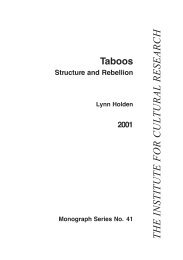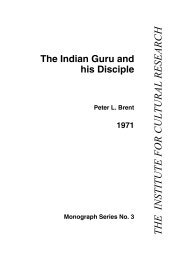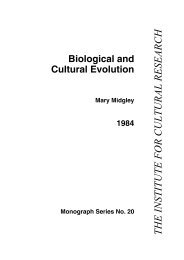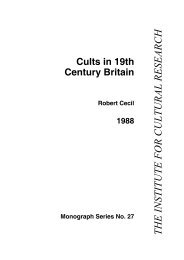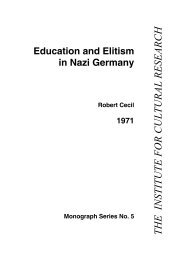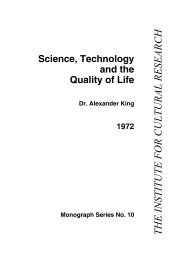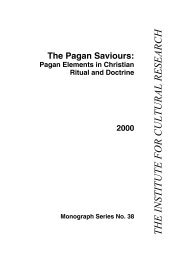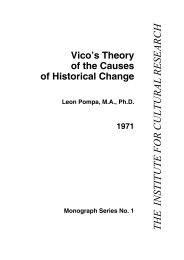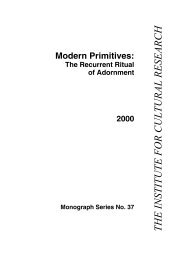Cultural Identity: Solution or Problem - The Institute For Cultural ...
Cultural Identity: Solution or Problem - The Institute For Cultural ...
Cultural Identity: Solution or Problem - The Institute For Cultural ...
You also want an ePaper? Increase the reach of your titles
YUMPU automatically turns print PDFs into web optimized ePapers that Google loves.
and cultivating. Between the sixteenth and eighteenth centuries, it<br />
acquired the connotation of cultivating, educating and improving the<br />
mind. Here is the root of the idea of culture as elite, ‘advanced’<br />
artistic f<strong>or</strong>ms, the product of extensive ‘cultivation’. From this<br />
notion of improvement there gradually derived the idea of culture as<br />
an abstract process of human cognition <strong>or</strong> the products of that<br />
process; culture here was a human faculty, it was what made humans<br />
human. This is the root of the (modern) late nineteenth-century<br />
sociological and anthropological use of the term. F<strong>or</strong> example,<br />
culture was defined by E.B.Tyl<strong>or</strong> (sometimes labelled ‘the father of<br />
anthropology’) as the sum total of activities of humans: ‘the complex<br />
whole which includes knowledge, belief, art, m<strong>or</strong>als, law, custom<br />
and any other capabilities and habits acquired by man as a member<br />
of society’. However, these complex wholes were seen as arranged<br />
on a ladder in which some people were m<strong>or</strong>e advanced culturally, <strong>or</strong><br />
‘civilised’, than others. Culture was seen as a process of human<br />
development <strong>or</strong> evolution over time and all the founders of social<br />
science were interested in human hist<strong>or</strong>y as a process of steady<br />
improvement and approach to the ‘civilised’ state (of which, not<br />
surprisingly, they considered European society to be the exponent).<br />
Human hist<strong>or</strong>y was the hist<strong>or</strong>y of culture as a s<strong>or</strong>t of ladder with<br />
‘savages’ and ‘barbarians’ at the bottom and civilised Europeans at<br />
the top. Some people had got ‘stuck’ on the ladder and these were the<br />
‘less civilised’ peoples. <strong>The</strong>re were various explanations f<strong>or</strong> why<br />
they had got stuck, ranging from environmental fact<strong>or</strong>s (the tropics<br />
debilitated people) to ‘racial’ (some ‘races’ were biologically inferi<strong>or</strong><br />
to others). F<strong>or</strong> all these scholars, culture was essentially used in the<br />
singular; hence E.B.Tyl<strong>or</strong>’s classic w<strong>or</strong>k was titled Primitive Culture<br />
(1871), not ‘Primitive Cultures’.<br />
<strong>The</strong>re is also a different current of usage of the w<strong>or</strong>d culture<br />
which goes back to the late eighteenth century. This is the idea of<br />
cultures, in the plural: various cultural units, located in specific<br />
geographical areas. <strong>The</strong> pluralist notion developed partly during the<br />
Romantic movement with the idea of folk and traditional cultures.<br />
<strong>The</strong>se cultures were identified as the authentic roots of national<br />
traditions and this linked the notion to two developments: i) the<br />
spread of nationalism in Europe and the search f<strong>or</strong> authentic<br />
national identities which defined each nation as unique and<br />
distinctive; ii) the Romantic search f<strong>or</strong> unsullied traditional<br />
9



